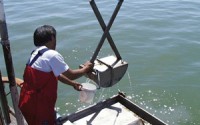![]() Download: Estuary News, April 2013 PDF
Download: Estuary News, April 2013 PDF
Boosting phytoplankton growth is a key part of the Bay Delta Conservation Plan, as the supply of these tiny algae at the base of the Delta’s food web has plunged over the last few decades. According to conventional wisdom, the best way to increase phytoplankton is to create shallow, slow waters to give algae plenty of light, as well as the chance to build up over time. But recent research upends this approach for ecosystems that, like the Delta, have been invaded by exotic clams.
“For many, this is a new way of thinking,” says US Geological Survey engineer Lisa Lucas, who reported this work with colleague Janet Thompson in the December 2012 issue of the journal Ecosphere. “Clams flip the ingrained model on its head.”
 The phytoplankton decline is mirrored by fish declines in the Delta, suggesting that the two are linked. Phytoplankton are eaten by zooplankton, and in turn these tiny animal-like organisms are eaten by small fish including threatened Delta smelt and young salmon. However, non-native clams can muck with this food web by sucking too much phytoplankton out of the water. Indeed, in much of the San Francisco Bay-Delta ecosystem, phytoplankton is overgrazed by two small invasive clams.
The phytoplankton decline is mirrored by fish declines in the Delta, suggesting that the two are linked. Phytoplankton are eaten by zooplankton, and in turn these tiny animal-like organisms are eaten by small fish including threatened Delta smelt and young salmon. However, non-native clams can muck with this food web by sucking too much phytoplankton out of the water. Indeed, in much of the San Francisco Bay-Delta ecosystem, phytoplankton is overgrazed by two small invasive clams.
The half-inch overbite clam, Potamocorbula amurensis, is infamous for grazing voraciously in the saltier zones of the Estuary. In the fresh waters of the Delta, however, the culprit is the roughly 2-inch Asian clam, Corbicula fluminea, which was introduced in the 1940s.
While it makes intuitive sense that phytoplankton will increase if there is more optimal algae habitat, Lucas and Thompson found that this can backfire in parts of the Delta that have been invaded by the Asian clam. This species can actually graze too fast for phytoplankton to keep up, even in the shallow, still waters that favor algae.
Clam invasions throw a spanner in the restoration works.[/caption]To see if the conventional wisdom held when Asian clams were present, the team developed two simple mathematical models. One represented the hypothesis that shallow water produces more phytoplankton (dubbed “shallower is greener”), and predicted algal growth over a range of depths. The other model represented the hypothesis that slower water produces more phytoplankton (dubbed “slower is greener”), and predicted algal growth over a range of water transport times, which reflect how long water stays in one place. “We isolated what’s key to each hypothesis and got rid of everything else that could complicate it,” Lucas explains.
The models predicted that, contrary to the traditional view, neither shallower nor slower was necessarily greener when Asian clams were present. The team field-tested their models by comparing algae, light, and clam grazing at sites that spanned the Delta. “We zoomed around in small boats taking water samples to measure chlorophyll and water clarity,” Lucas says. Clam grazing was estimated based on sediment samples. “Metal jaw-like contraptions called benthic grabs bring up a known amount of sediment, along with any clams,” she explains.
Data from more than 200 sites across the Delta suggests that shallow, slow waters were not always greener when clams were present. “We don’t know how to predict or control where clams will be, so this is a big uncertainty when restoring or creating habitat in the Delta,” Lucas says. “You just don’t know what you’re going to get.”

CONTACT: Lisa Lucas